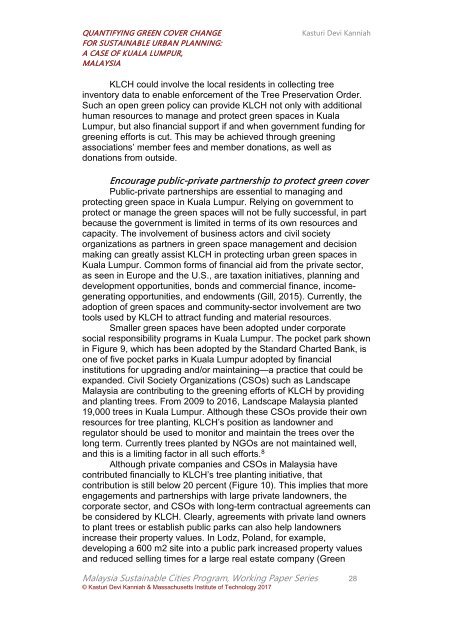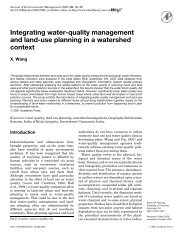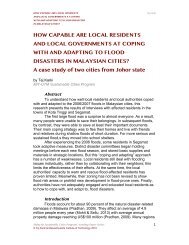Kanniah
Create successful ePaper yourself
Turn your PDF publications into a flip-book with our unique Google optimized e-Paper software.
QUANTIFYING GREEN COVER CHANGE<br />
FOR SUSTAINABLE URBAN PLANNING:<br />
A CASE OF KUALA LUMPUR,<br />
MALAYSIA<br />
Kasturi Devi <strong>Kanniah</strong><br />
KLCH could involve the local residents in collecting tree<br />
inventory data to enable enforcement of the Tree Preservation Order.<br />
Such an open green policy can provide KLCH not only with additional<br />
human resources to manage and protect green spaces in Kuala<br />
Lumpur, but also financial support if and when government funding for<br />
greening efforts is cut. This may be achieved through greening<br />
associations’ member fees and member donations, as well as<br />
donations from outside.<br />
Encourage public-private partnership to protect green cover<br />
Public-private partnerships are essential to managing and<br />
protecting green space in Kuala Lumpur. Relying on government to<br />
protect or manage the green spaces will not be fully successful, in part<br />
because the government is limited in terms of its own resources and<br />
capacity. The involvement of business actors and civil society<br />
organizations as partners in green space management and decision<br />
making can greatly assist KLCH in protecting urban green spaces in<br />
Kuala Lumpur. Common forms of financial aid from the private sector,<br />
as seen in Europe and the U.S., are taxation initiatives, planning and<br />
development opportunities, bonds and commercial finance, incomegenerating<br />
opportunities, and endowments (Gill, 2015). Currently, the<br />
adoption of green spaces and community-sector involvement are two<br />
tools used by KLCH to attract funding and material resources.<br />
Smaller green spaces have been adopted under corporate<br />
social responsibility programs in Kuala Lumpur. The pocket park shown<br />
in Figure 9, which has been adopted by the Standard Charted Bank, is<br />
one of five pocket parks in Kuala Lumpur adopted by financial<br />
institutions for upgrading and/or maintaining—a practice that could be<br />
expanded. Civil Society Organizations (CSOs) such as Landscape<br />
Malaysia are contributing to the greening efforts of KLCH by providing<br />
and planting trees. From 2009 to 2016, Landscape Malaysia planted<br />
19,000 trees in Kuala Lumpur. Although these CSOs provide their own<br />
resources for tree planting, KLCH’s position as landowner and<br />
regulator should be used to monitor and maintain the trees over the<br />
long term. Currently trees planted by NGOs are not maintained well,<br />
and this is a limiting factor in all such efforts. 8<br />
Although private companies and CSOs in Malaysia have<br />
contributed financially to KLCH’s tree planting initiative, that<br />
contribution is still below 20 percent (Figure 10). This implies that more<br />
engagements and partnerships with large private landowners, the<br />
corporate sector, and CSOs with long-term contractual agreements can<br />
be considered by KLCH. Clearly, agreements with private land owners<br />
to plant trees or establish public parks can also help landowners<br />
increase their property values. In Lodz, Poland, for example,<br />
developing a 600 m2 site into a public park increased property values<br />
and reduced selling times for a large real estate company (Green<br />
Malaysia Sustainable Cities Program, Working Paper Series 28<br />
© Kasturi Devi <strong>Kanniah</strong> & Massachusetts Institute of Technology 2017






